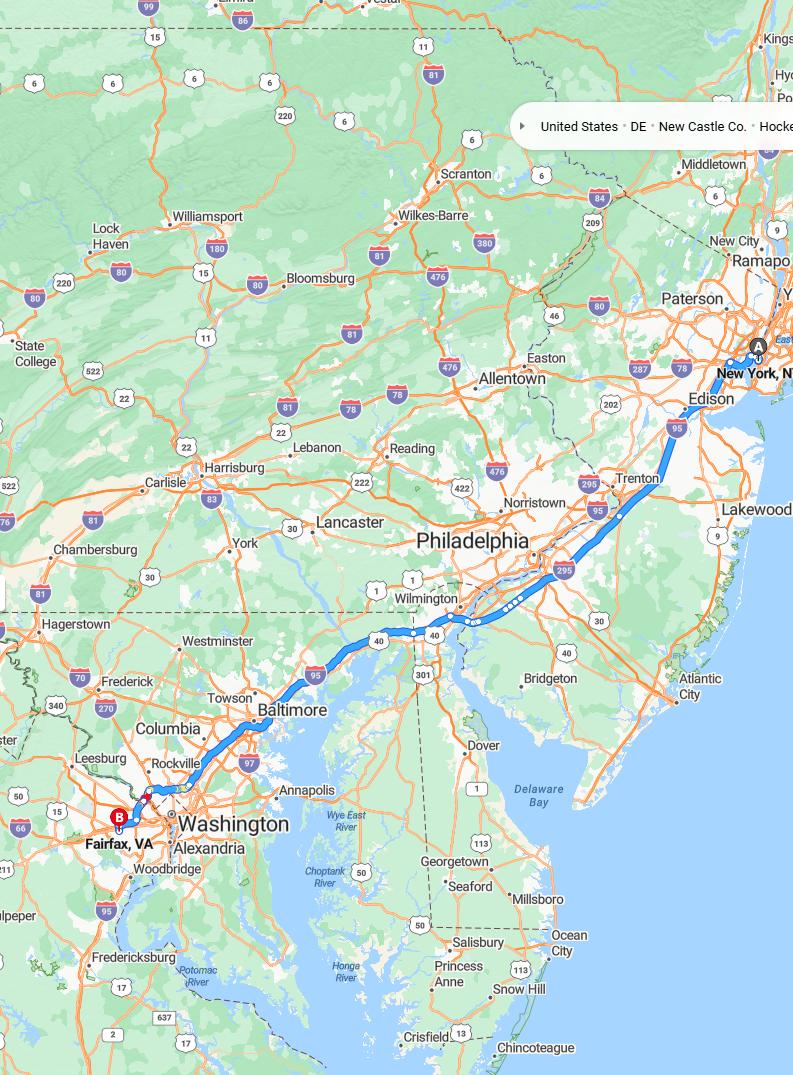Distance and estimated driving time
The drive from New York City to Fairfax covers approximately 245 miles and typically takes around 4 hours and 5 minutes, depending on traffic conditions. Travelers will primarily use the I-95 South route, which offers a direct path through key highways. The journey also involves traversing the New Jersey Turnpike, a major interstate facilitating efficient travel between these regions. Proper planning for possible delays and rest stops can help ensure a smooth and timely trip.
Driving route
Embarking on a road trip from New York City to Fairfax, travelers begin their journey in the bustling urban landscape of New York. The route typically takes them southwest, passing through Trenton, the capital of New Jersey, known for its historic sites. After crossing into Delaware, travelers continue southward, briefly passing through or near the state's scenic areas before reaching Baltimore, a vibrant city famous for its Inner Harbor. Continuing south, the journey proceeds through Maryland and Washington D.C., the nation's capital, offering a glimpse into American history and political life. Finally, the trip concludes in Fairfax, a key suburban hub near the Washington metropolitan area, completing a diverse and culturally rich coastal-to-suburban traverse.

Map of the fastest route
The fastest route from New York City to Fairfax typically begins by taking I-95 South, which provides a direct and efficient path through key states. Traveling through Trenton, drivers continue southwest, passing near Delaware and Maryland, offering scenic views and manageable traffic flow. The route then proceeds through Baltimore, a major urban hub with numerous amenities, before crossing into Washington, D.C., and finally reaching Fairfax. This corridor is well-maintained and optimized for speed, making it the most practical choice for a swift and comfortable journey.
Traffic conditions along the route
Traffic conditions along the route from New York City to Fairfax can vary significantly depending on the time of day. Typically, drivers will encounter heavy congestion in and around New York City and Trenton, especially during rush hours. As you progress south through Delaware, Maryland, and Baltimore, traffic tends to ease, but occasional delays may occur near urban centers and major interchanges. Near Washington and entering Fairfax, drivers might experience moderate to heavy traffic depending on the time, with potential slowdowns during peak commuting hours.
Roadside attractions and landmarks
Traveling from New York City to Fairfax offers a variety of roadside attractions and landmarks that enrich the journey. In Trenton, visitors can explore the historic New Jersey State House and nearby museums. As you pass through Delaware, the First State National Historical Park provides an insightful glimpse into early American history, while Baltimore's Inner Harbor features vibrant waterfront attractions and the National Aquarium. Approaching Washington and Fairfax, tourists can visit iconic landmarks such as the National Mall, the Washington Monument, and George Mason University, making the drive both scenic and culturally enriching.
Rest stops and parking areas
When driving from New York City to Fairfax, travelers will find various rest stops and parking areas along the route to ensure a comfortable journey. In New York City and Trenton, urban parking options are available, but dedicated highway rest areas are limited, so plan accordingly. As you pass through Delaware and Maryland, you'll encounter several well-maintained rest areas offering amenities such as restrooms, picnic areas, and vending machines, especially near major highways. Approaching Baltimore, Washington, and Fairfax, numerous rest stops and parking facilities provide convenient break points with ample parking, allowing drivers to recharge before continuing their trip.
Weather forecast for the driving day
The weather forecast for your drive from New York City to Fairfax suggests a mix of conditions along the route. Expect possibility of rain or showers in the Trenton and Delaware areas, potentially affecting driving visibility and comfort. As you pass through Maryland and Baltimore, temperatures are projected to remain mild, with chances of light rain lingering but clearing up near Washington and Fairfax. Overall, it's advisable to be prepared for varying weather conditions, including potential rain and fluctuating temperatures, to ensure a safe and smooth journey.
Cost estimate for tolls and fuel
The drive from New York City to Fairfax involves passing through several states, resulting in multiple tolls and fuel costs. Estimated toll expenses range from $25 to $40, depending on the specific routes taken through New Jersey, Delaware, and Maryland, where tolls are common along major highways. Fuel costs will depend on the vehicle's fuel efficiency, with an average vehicle consuming about 25 miles per gallon; covering approximately 225 miles, you can expect to spend around $30 to $40 on fuel, assuming current diesel or gasoline prices. Overall, planning for approximately $60 to $80 in tolls and fuel will help ensure a smooth and budgeted trip.
Safety tips for long-distance driving
When embarking on a long-distance drive from New York City to Fairfax, it's essential to prioritize safety to ensure a smooth journey. Plan your route in advance, taking regular breaks to rest and stay alert, especially when passing through busy areas like Trenton, Baltimore, and Washington. Maintain a safe driving distance from other vehicles, follow speed limits, and avoid driving fatigue by staying well-hydrated and energized. Additionally, ensure your vehicle is in good condition with functioning brakes, tires, and lights, and always keep emergency supplies handy in case of unexpected situations.
Alternative routes and detours
When driving from New York City to Fairfax, travelers can consider alternative routes such as taking the I-78 West to Harrisburg and then connecting to I-81 South, which bypasses some congested areas near Baltimore and Washington. Detours around major traffic hubs like Baltimore or Washington can be planned using GPS navigation apps that suggest less crowded highways or temporary road closures. For a scenic alternative, drivers might explore routes through Pennsylvania or via PA Turnpike, which can offer a more relaxed drive at the expense of additional miles. Always check current traffic conditions and roadwork updates before departure to ensure an efficient and smooth journey.
